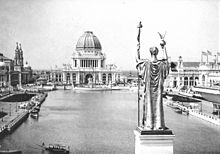Edward Clark Potter
This article needs additional citations for verification. (February 2022) |
Edward Clark Potter | |
|---|---|
School of the Museum of Fine Arts, Boston, Académie Julian | |
| Known for | sculpture |

Edward Clark Potter (November 26, 1857 – June 21, 1923) was an American sculptor best known for his equestrian and animal statues. His most famous works are the marble lions, nicknamed Patience and Fortitude, in front of the New York Public Library Main Branch
Early years
Born in
Career
In 1883 he became an assistant to Daniel Chester French and concentrated on animal studies and working as a manager and salesman in the quarries.

From 1887 to 1889 he studied sculpture at the
For the 1893 World's Columbian Exposition in Chicago he collaborated with his teacher and friend Daniel Chester French on several of the important sculptures of the exposition. Unfortunately these statues, like most of the architecture of the fair, were made of staff, a temporary material of plaster, cement, and jute fibers, first used in buildings of the Paris exhibition in 1878.
He was elected to the

His most famous work is the pair of pink Tennessee marble lions in front of the New York Public Library Main Branch, carved by the Piccirilli brothers. Potter was recommended for this commission by Augustus Saint-Gaudens. The lions were originally nicknamed "Leo Astor" and "Leo Lenox", for the two private libraries that formed the collection's core, but mayor Fiorello La Guardia renamed them for qualities New Yorkers were showing in weathering the Great Depression—Patience (on the left or south) and Fortitude (on the right or north)—and those names have stuck.
A resident of Greenwich, Connecticut, after 1902, he sculpted the memorial to Raynal Bolling there in 1922. The Cos Cob section of Greenwich is considered one of the birthplaces of American Impressionism. Potter was a founder and first president of the Greenwich Society of Artists, founded in 1912.
He died at his summer home in New London, Connecticut.
Collaborations with Daniel Chester French
World's Columbian Exposition, Chicago, 1893
(These were temporary sculptures, all were destroyed.)
- Grand Court[1]
- The Republic (replicated as Statue of The Republic)[2]
- Statue of Industry[3]
- Statue of Plenty[4]
- Statue of The Teamster[5]
- Quadriga (horse-drawn chariot)[6]
- Quadriga outriders[7]
Equestrian statues
- Equestrian statue of Lieutenant General Ulysses S. Grant, Fairmount Park, Philadelphia, Pennsylvania (1893–98).[8]
- Equestrian statue of George Washington, Place d'Iéna, Paris, France (1900).
- Equestrian statue of George Washington, Washington Park, Chicago, Illinois (1900–04). This is a replica of the statue in Paris.
- Massachusetts Statehouse, Boston, Massachusetts (1903).
- Progress of the State quadriga, Minnesota State Capitol, Cass Gilbert, architect, St. Paul, Minnesota (1905–1907).
- Equestrian statue of Charles Devens, Worcester, Massachusetts (1906).
- Equestrian statue of a bugler, "Soldier's Monument" Brookline, MA, (1915)
Gallery
-
World's Columbian Exposition, Chicago (1893). Potter's Quadriga (horse-drawn chariot) is atop the pavilion behind The Republic.
-
Indian Corn
(Woman by Daniel Chester French) -
Equestrian Statue of George Washington, Place d'Iéna, Paris, France (1900).
-
Dedication of theMassachusetts Statehouse, Boston, MA (1903).
-
Progress of the State Quadriga, Minnesota State Capitol, St. Paul, Minnesota (1905–1907).
Selected works
- Sleeping Faun, Metropolitan Museum of Art, New York City (1887–89).[1]
- Bust of U.S. Capitol, Washington, DC (1890–1892).[2]
- Governor Austin Blair, Michigan State Capitol, Lansing, Michigan (1895–1898).
- Robert Fulton, Rotunda Reading Room, Library of Congress, Washington, DC (1897). One of 16 bronze statues set around the third-floor balustrade.
- John Paul Jones, Dewey Triumphal Arch, Madison Square, New York City (1899, destroyed).
- Equestrian Statue of Major General Henry W. Slocum, Gettysburg Battlefield, Gettysburg, Pennsylvania (1902).[3]
- Equestrian Statue of Major General Charles Devens, Worcester County Courthouse, Worcester, Massachusetts (1905–06).[4] Archived November 10, 2012, at the Wayback Machine
- Indian Religion (Buddha), Brooklyn Museum, Brooklyn, New York (1907–1909).[5]
- Indian Philosophy (Sankara), Brooklyn Museum, Brooklyn, New York (1907–1909).[6]
- Sighting the Enemy (George Armstrong Custer Equestrian Monument), Monroe, Michigan (1908–1910).
- Equestrian Statue of Major General George B. McClellan, Smith Memorial Arch, Philadelphia, Pennsylvania (1909–1911).[7]
- Lions, New York Public Library Main Branch, New York City (1910–11).
- Equestrian Statue of Major General Philip Kearny, Arlington National Cemetery, Arlington, Virginia (1912–1914).
- Bust of Sidney Lanier on the Sidney Lanier Monument, Piedmont Park, Atlanta, Georgia (1914).
- The Bugler (Brookline Civil War Monument), Brookline, Massachusetts (1915).[8]
- Equestrian Statue of Major General John A. McClernand, Vicksburg, Mississippi (1919).[9]
- Raynal Bolling Memorial, Greenwich, Connecticut (1922).
-
Governor Austin Blair, Michigan State Capitol, Lansing, Michigan (1895–1898).
-
General H. W. Slocum, Gettysburg, Pennsylvania (1920)
-
George Armstrong Custer Equestrian Monument, Monroe, Michigan (1908–1910).
-
Major General Philip Kearny, Arlington National Cemetery, Arlington, Virginia (1912–1914).
-
Raynal Bolling Memorial, Greenwich, Connecticut (1922).
References
- ^ "Looking East in the Grand Court". washingtonmo.com. Retrieved January 27, 2024.
- ^ "The Dream City: The Heroic Statue of the Republic". Archived from the original on November 21, 2003. Retrieved December 7, 2003.
- ^ The Dream City: Paul V. Galvin Digital History Collection
- ^ "Archived copy". Archived from the original on October 1, 2003. Retrieved December 7, 2003.
{{cite web}}: CS1 maint: archived copy as title (link) - ^ "The Teamster [sculpture] /". siris-juleyphoto.si.edu. Retrieved January 27, 2024.
- ^ "Archived copy". Archived from the original on December 3, 2005. Retrieved December 7, 2003.
{{cite web}}: CS1 maint: archived copy as title (link) - ^ "Archived copy". Archived from the original on February 19, 2004. Retrieved December 7, 2003.
{{cite web}}: CS1 maint: archived copy as title (link) - ^ Image philart.net










